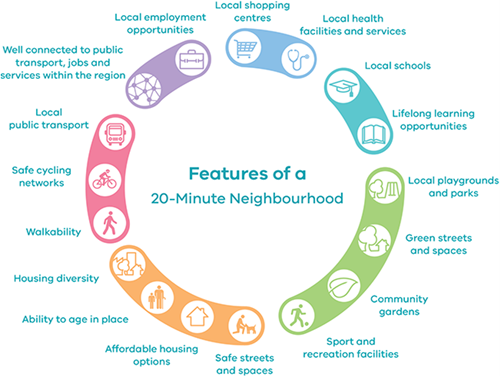08 Dec 2020
The 20 minute neighbourhood
Like many people, the first lockdown made think quite differently about not only the home I live in but also what I can walk to from it. I was lucky that my local area met my every day needs reasonably well, but we know that was not the case for everyone. Place Alliance recently published their Home Comforts report which summarises findings of a national survey looking at how well or how poorly the design of our homes and their immediate neighbourhoods supported us during the period of lockdown. It found that proximity to green space within a short walk from home was the strongest predictor of satisfaction with neighbourhoods. Being within an easy walking distance to local facilities (shops and services) was a very close second. Satisfaction dropped away rapidly when it took longer than 10 minutes to walk to these amenities. This 10 minute walking radius fits well a concept which was already beginning to gain traction before the pandemic hit – the 20 minute neighbourhood (10 minutes walking to the destination and 10 minutes back).
The idea of the 20 minute neighbourhood was developed as part of the Portland plan in Oregon. The concept was already finding its way into planning policy discussion worldwide before Covid-19 lockdowns around the globe shone a light on the importance of the liveability of our neighbourhoods. The periods of lockdown stress tested our homes and local environments and how resilient they are in terms of meeting our day-to-day needs, in ways we could not have imagined a year ago, but these collective experiences also created opportunities to think about the places and spaces we value.
The Town and County Planning Association’s (TCPA) webinar 'The 20 minute neighbourhood - learning from down under' provides an interesting insight into how the concept is being embedded into policy and decision making in places like Melbourne in Australia and Hamilton in New Zealand. Joined up working and partnership across planning, transport and health teams, as well as health bodies, industry and the community are enabling coalition and consensus building. I would recommend anyone interested in the idea to watch this webinar and see how advocacy is playing a strong role making changes to policy thinking which will improve people’s quality of life.
The 20-minute neighbourhood concept is really about ‘nearness’. Do you have the things you need for your daily life near you? It is about ‘living locally’ and giving people the ability to meet most of their daily needs within short walk from home, with access to safe cycling and local transport options. Sustrans were calling on the next UK government to make the 20 minute neighbourhood concept a central principle of the planning system before the last election in 2019. The TCPA and Sport England believe that the idea of 20-minute neighbourhoods provides local authorities with an easily understandable concept that could be taken forward as a founding principle within the English planning system as an effective way of creating healthier active communities, and I agree! Good sustainable place-making fits so well into this tangible concept. It is a holistic approach and includes housing diversity to meet a range of needs, and affordable housing is a key features of a 20 minutes neighbourhood, as this wheel from the Melbourne Plan demonstrates.

How different many people’s experience of lockdown would have been if they had even half of these things on this wheel within their local neighbourhood! But it is not just for lockdown, these are things we value for our quality of life, global pandemics aside. New housing estates disconnected from facilities where you must get in your car even to go and buy a pint of milk just don’t cut it in this framework of inclusive, vibrant and healthy neighbourhoods. Worryingly newer neighbourhoods came out worst in the Home Comforts report with the data showing a progressive deterioration of the neighbourhood experience of lockdown in the most recently established neighbourhoods. 20 minute neighbourhoods are a simple way of thinking about and underpinning strong and sustainable communities and I look forward to seeing TCPA and Sport England’s ‘how to’ document in 2021 for local authorities and community to take this concept forward.
Hannah Keilloh is a policy and practice officer at the Chartered Institute of Housing. She leads on all policy work surrounding planning. Hannah is member of the Royal Town Planning Institute.


